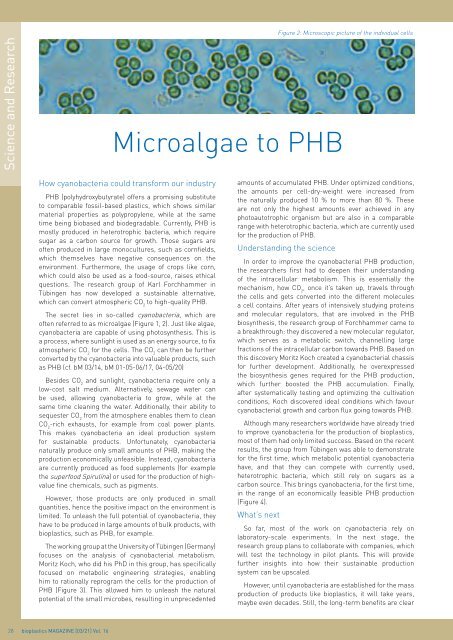issue 03/2021
Highlights: Bottles / Blow Moulding Joining Bioplastics Basics: Carbon Capture
Highlights:
Bottles / Blow Moulding
Joining Bioplastics
Basics: Carbon Capture
- No tags were found...
You also want an ePaper? Increase the reach of your titles
YUMPU automatically turns print PDFs into web optimized ePapers that Google loves.
Figure 2: Microscopic picture of the individual cells<br />
Science and Research<br />
Microalgae to PHB<br />
How cyanobacteria could transform our industry<br />
PHB (polyhydroxybutyrate) offers a promising substitute<br />
to comparable fossil-based plastics, which shows similar<br />
material properties as polypropylene, while at the same<br />
time being biobased and biodegradable. Currently, PHB is<br />
mostly produced in heterotrophic bacteria, which require<br />
sugar as a carbon source for growth. Those sugars are<br />
often produced in large monocultures, such as cornfields,<br />
which themselves have negative consequences on the<br />
environment. Furthermore, the usage of crops like corn,<br />
which could also be used as a food-source, raises ethical<br />
questions. The research group of Karl Forchhammer in<br />
Tübingen has now developed a sustainable alternative,<br />
which can convert atmospheric CO 2<br />
to high-quality PHB.<br />
The secret lies in so-called cyanobacteria, which are<br />
often referred to as microalgae (Figure 1, 2). Just like algae,<br />
cyanobacteria are capable of using photosynthesis. This is<br />
a process, where sunlight is used as an energy source, to fix<br />
atmospheric CO 2<br />
for the cells. The CO 2<br />
can then be further<br />
converted by the cyanobacteria into valuable products, such<br />
as PHB (cf. bM <strong>03</strong>/14, bM 01-05-06/17, 04-05/20)<br />
Besides CO 2<br />
and sunlight, cyanobacteria require only a<br />
low-cost salt medium. Alternatively, sewage water can<br />
be used, allowing cyanobacteria to grow, while at the<br />
same time cleaning the water. Additionally, their ability to<br />
sequester CO 2<br />
from the atmosphere enables them to clean<br />
CO 2<br />
-rich exhausts, for example from coal power plants.<br />
This makes cyanobacteria an ideal production system<br />
for sustainable products. Unfortunately, cyanobacteria<br />
naturally produce only small amounts of PHB, making the<br />
production economically unfeasible. Instead, cyanobacteria<br />
are currently produced as food supplements (for example<br />
the superfood Spirulina) or used for the production of highvalue<br />
fine chemicals, such as pigments.<br />
However, those products are only produced in small<br />
quantities, hence the positive impact on the environment is<br />
limited. To unleash the full potential of cyanobacteria, they<br />
have to be produced in large amounts of bulk products, with<br />
bioplastics, such as PHB, for example.<br />
The working group at the University of Tübingen (Germany)<br />
focuses on the analysis of cyanobacterial metabolism.<br />
Moritz Koch, who did his PhD in this group, has specifically<br />
focused on metabolic engineering strategies, enabling<br />
him to rationally reprogram the cells for the production of<br />
PHB (Figure 3). This allowed him to unleash the natural<br />
potential of the small microbes, resulting in unprecedented<br />
amounts of accumulated PHB. Under optimized conditions,<br />
the amounts per cell-dry-weight were increased from<br />
the naturally produced 10 % to more than 80 %. These<br />
are not only the highest amounts ever achieved in any<br />
photoautotrophic organism but are also in a comparable<br />
range with heterotrophic bacteria, which are currently used<br />
for the production of PHB.<br />
Understanding the science<br />
In order to improve the cyanobacterial PHB production,<br />
the researchers first had to deepen their understanding<br />
of the intracellular metabolism. This is essentially the<br />
mechanism, how CO 2<br />
, once it’s taken up, travels through<br />
the cells and gets converted into the different molecules<br />
a cell contains. After years of intensively studying proteins<br />
and molecular regulators, that are involved in the PHB<br />
biosynthesis, the research group of Forchhammer came to<br />
a breakthrough: they discovered a new molecular regulator,<br />
which serves as a metabolic switch, channelling large<br />
fractions of the intracellular carbon towards PHB. Based on<br />
this discovery Moritz Koch created a cyanobacterial chassis<br />
for further development. Additionally, he overexpressed<br />
the biosynthesis genes required for the PHB production,<br />
which further boosted the PHB accumulation. Finally,<br />
after systematically testing and optimizing the cultivation<br />
conditions, Koch discovered ideal conditions which favour<br />
cyanobacterial growth and carbon flux going towards PHB.<br />
Although many researchers worldwide have already tried<br />
to improve cyanobacteria for the production of bioplastics,<br />
most of them had only limited success. Based on the recent<br />
results, the group from Tübingen was able to demonstrate<br />
for the first time, which metabolic potential cyanobacteria<br />
have, and that they can compete with currently used,<br />
heterotrophic bacteria, which still rely on sugars as a<br />
carbon source. This brings cyanobacteria, for the first time,<br />
in the range of an economically feasible PHB production<br />
(Figure 4).<br />
What’s next<br />
So far, most of the work on cyanobacteria rely on<br />
laboratory-scale experiments. In the next stage, the<br />
research group plans to collaborate with companies, which<br />
will test the technology in pilot plants. This will provide<br />
further insights into how their sustainable production<br />
system can be upscaled.<br />
However, until cyanobacteria are established for the mass<br />
production of products like bioplastics, it will take years,<br />
maybe even decades. Still, the long-term benefits are clear<br />
28 bioplastics MAGAZINE [<strong>03</strong>/21] Vol. 16


















